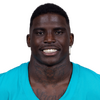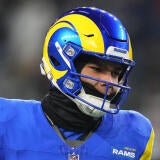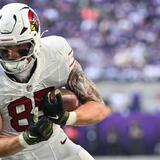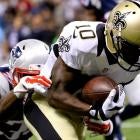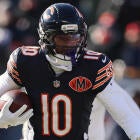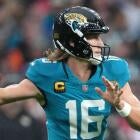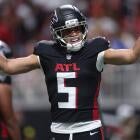2017 Fantasy Football Draft Prep: Cam, Cooks and two Murrays top class of Busts 1.0
Cam Newton and Latavius Murray are hurt, and Brandin Cooks and DeSean Jackson get a downgrade in Fantasy value with their new teams. Jamey Eisenberg looks at these players and more in the first version of his busts column.

The draft prep column that I don’t like writing this early in the offseason is busts. That’s because it’s best to use Average Draft Position to judge if a player will be worth his value.
For example, we had DeAndre Hopkins listed as a bust last year. While I didn’t expect him to flop as poorly as he did (thanks, Brock Osweiler), I also didn’t like that he was being drafted as the No. 4 receiver at No. 8 overall. He failed in his production, and he definitely didn’t live up to his lofty ADP.
This is the first of three versions of this column we’ll be writing between now and August, and the NFL Draft will change our views on certain players, along with other potential moves. But most likely you won’t see any of these players on my Fantasy teams this year.
Unless, of course, they fall on Draft Day, which could happen. But at this point in the offseason, these are players I plan to avoid. And you might want to do the same thing given that their ADP could be too high compared to their eventual disappointing production.
Quarterbacks
It seems like a bad 2016 season will carry over to this year.
Newton will undergo surgery March 30 to repair a partially torn rotator cuff in his throwing shoulder he hurt in Week 14 last season. He won’t resume throwing at all for three months and won’t throw with the team for four months, which means he’s questionable to return for the start of training camp. He should be ready for Week 1, but it’s hard to trust Newton as a No. 1 Fantasy quarterback. After he was the best player at his position in 2015 when he passed for 3,837 yards, 35 touchdowns and 10 interceptions and ran for 636 yards and 10 touchdowns, he regressed last season to the No. 19 Fantasy quarterback with 3,509 passing yards, 19 touchdowns and 14 interceptions and 359 rushing yards and five touchdowns.
Coach Ron Rivera already said he wanted Newton to run less this year, which was his best Fantasy asset, and now his passing could be further compromised coming off shoulder surgery. Keep in mind he’s a career 58.4 percent passer, and he just lost a valuable weapon in free agency with Ted Ginn’s departure to New Orleans.
I would only draft Newton with a late-round pick, and he’s more of a No. 2 Fantasy quarterback than a guaranteed starter.
Running backs
Of all the players on this list, Murray is the one with the best chance to live up to his expected Average Draft Position, which is likely in the middle of Round 2. He’s still going to get plenty of work, and he’s running behind one of the best offensive lines in the NFL (Pro Football Focus graded the Titans at No. 1 in 2016). But there are two areas of concern working against Murray this season, which are age/wear and tear and the presence of second-year running back Derrick Henry.
Murray was able to keep Henry in a secondary role in 2016 because he had a tremendous year with 293 carries for 1,287 yards (4.39-yards per carry) and nine touchdowns and 53 catches for 377 yards. It wasn’t quite the dominant performance he put together in 2014 with the Cowboys, but he was dramatically improved from his failed campaign in 2015 with the Eagles. And now he has to do it again at 29, with Henry expected to take on a bigger role (he had at least nine touches in three of his final four games).
Murray struggled down the stretch last season with a foot injury that he played through, but he averaged just 3.5-yards per carry over his final six games, including just two with double digits in Fantasy points in a standard league in his final five outings. Maybe all the work he’s had over the past three seasons (878 carries and 1,032 total touches in the regular season) could be catching up to him, but he feels a little risky heading into this year. Again, I wouldn’t sprint away from Murray, but I’d look at other running backs like Jay Ajayi, Carlos Hyde and even Lamar Miller ahead of him. And if you draft Murray, just handcuff him with Henry in Round 6 to lock up this backfield in case this is the year Murray breaks down.
Murray was a serviceable Fantasy running back last year for the Raiders when he finished No. 13 in standard leagues with 195 carries for 788 yards (4.04-yards per carry) and 12 touchdowns and 33 catches for 264 yards. But things will change for him this year after he signed as a free agent with Minnesota, where he will be asked to take over for Adrian Peterson.
Within a week after signing, Murray underwent ankle surgery, which should keep him sidelined until training camp. He will have to learn a new system on the fly, and he’ll also have to prove he can run with success behind an inferior offensive line to what he left behind in Oakland. Per Pro Football Focus, the Raiders had the No. 4 offensive line in 2016, and the Vikings were No. 29. Minnesota did add new tackles Riley Reiff and Mike Remmers, but Murray wasn’t exactly great behind Oakland’s offensive line. By comparison, Jalen Richard (5.9) and DeAndre Washington (5.4) had better rushing averages, and both had better yards after contact (Richard was at 3.6 and Washington was at 3.3) than Murray (2.6). In Minnesota, Murray will also compete with Jerick McKinnon for playing time, and McKinnon should have the edge on passing downs.
I’d settle for Murray as a No. 3 Fantasy running back, but someone will draft him as a No. 2 option. You’re better off passing on Murray and drafting McKinnon with a late-round pick.
Blount’s Fantasy value could be saved if he re-signs with the Patriots, but it doesn’t appear like that’s going to happen after New England added Rex Burkhead in free agency to go with Dion Lewis and James White.
There could be a scenario where Blount ends up in a good situation (Oakland maybe?), but his options might be limited as a 30-year-old, one dimensional runner. While he’s coming off a career season with 299 carries for 1,161 yards and 18 touchdowns, which led the NFL, he’s not known for being a good receiver out of the backfield with only 46 catches for 337 yards and one touchdown over seven seasons.
Blount will need to be in a good offense where he can get at least 250 carries and work at the goal line, and he might have to settle for being a backup and waiting for an injury to get a chance at increased playing time. Once he signs we can ultimately determine his Fantasy value, but he’s looking more like a late-round pick in the majority of leagues than someone to target as a potential starter or even a flex option.
Gore was solid in 2016. He moved into No. 8 on the NFL’s all-time rushing list at 13,065 yards and became the first running back at 33 years or older to have a 1,000-yard campaign since John Riggins in 1984. Gore finished with 263 carries for 1,025 yards (3.9-yards per carry) and four touchdowns and 38 catches for 277 yards and four touchdowns, and he was the No. 12 Fantasy running back in standard leagues. He was No. 10 in 2015, but at some point Father Time is going to catch up with him.
We’d also like the Colts to find some competition for Gore to improve this offense because while Gore has been more than serviceable, he’s far from explosive at this point in his career. The NFL Draft will likely be where Indianapolis brings in a challenger for Gore, but he’s going to be a risky Fantasy option if he remains the starter since he turns 34 in May. He needs less than 200 yards to pass Eric Dickerson (13,259) for No. 7 on the all-time rushing list, and he’s within striking distance of Jerome Bettis (13,662) at No. 6, LaDainian Tomlinson (13,684) at No. 5 and Curtis Martin (14,101) at No. 4. But we’d be shocked if he reached that total, and 2016 might have been the last good year for Gore, who should eventually get into the NFL Hall of Fame.
He’s only worth drafting in Round 7 or later even if he remains the starter for the Colts this year.
It’s funny how Fantasy owners treat certain players. You see a name and want to gravitate toward them because of past performance, no matter the circumstances.
Peterson, who just turned 32, is without a team, and few have shown interest in him during free agency thus far. He was limited to three games last year because of injuries, and it’s highly doubtful he’ll ever regain his prowess as one of the best running backs in NFL history at this point in his career. But in our latest 12-team standard mock draft, he was still drafted in Round 6 at No. 66 overall. And on Fantasy Pros his consensus draft ranking is No. 18 among running backs. Both scenarios are too high for me even if he lands a starting job, which appears unlikely at this point, and I would only draft him with a late-round pick in the majority of leagues.
He was once a player every Fantasy owner coveted, and rightfully so. But those days are gone, and Peterson is not someone you should reach for on Draft Day any more.
Wide receivers
In our latest 12-team standard mock draft, which is just after Cooks was traded from New Orleans to New England, Cooks was selected at the end of Round 2, which is way too high following this move. Maybe you can look for him in Round 4, especially in PPR, but Round 5 is where you should plan to target Cooks this year.
Adding Cooks is great for the Patriots and Tom Brady, but this is a tremendous blow to Cooks’ Fantasy value. Ditto Julian Edelman, who should also be considered a bust candidate. Cooks was the No. 9 Fantasy receiver in standard leagues in 2016 and No. 11 in 2015, but the Patriots haven’t had a receiver finish as a No. 1 option since Wes Welker in 2012. That’s because Brady spreads the ball around, especially to Rob Gronkowski in the red zone. And now Brady has the most dynamic receiving corps he’s ever had with Gronkowski, Cooks, Edelman, Malcolm Mitchell, Chris Hogan, Dwayne Allen, Dion Lewis, Rex Burkhead and James White.
Cooks has never needed a ton of targets to succeed (he was No. 24 in targets in 2016 with 117), but he’s averaged at least 7.3 targets a game over the past two years. That’s expected to decline, and we know about his struggles when he’s played away from New Orleans. In 21 career road games, Cooks has seven touchdowns and two games with over 100 receiving yards. Compare that to his production in 21 games at home, where he has 13 touchdowns and five games with at least 100 receiving yards.
He’s still going to be a good Fantasy receiver with the Patriots, but he’s not going to be elite. Just be wary of drafting him before Round 4 in most formats this year.
Fitzgerald is an interesting study in how to view season-long production compared to weekly stats.
Over the course of the past two seasons, Fitzgerald was great as the No. 9 Fantasy receiver in standard leagues in 2015, and he was No. 16 last year. But in 2016 he had double digits in Fantasy points just five times and six points or less in eight games, and in 2015 he had six games with at least 10 Fantasy points and five outings with six points or less. It’s great that he’s back for his 14th season, and he should continue to be a solid weapon for the Cardinals and quarterback Carson Palmer. But with John Brown expected to be healthy and the emergence of J.J. Nelson, we could see Fitzgerald take a step back in production, especially since he turns 34 in August. He’s still more than serviceable in PPR leagues with at least 107 catches in each of the past two seasons, and maybe he can squeeze out a third-consecutive 1,000-yard campaign and six touchdowns, which he’s done each of the past two years. Or this could be the year where his stats suffer, and you just want to make sure you
draft him accordingly.
He’s a borderline No. 3 Fantasy receiver in standard leagues and just a No. 3 option in PPR, and you should only look for him with a mid-round pick in all formats.
Like Fitzgerald, Sanders had good stats over the course of the season last year, but he was tough to trust week-to-week. And that should be the same thing this year with another questionable situation at quarterback and a new head coach. While we like the return of Mike McCoy as the offensive coordinator in Denver (he held that position from 2010-12), don’t be surprised if coach Vance Joseph is a little on the conservative side with a defensive background. And it’s doubtful the Broncos will upgrade their quarterbacks from Trevor Siemian or Paxton Lynch, which won’t help Sanders.
Sanders was the No. 24 Fantasy receiver in standard leagues last year with 79 catches for 1,032 yards and five touchdowns on 139 targets, but he only had four games with double digits in Fantasy points. Sanders also had 10 games with six points or less, and he’s not worth drafting as a No. 2 Fantasy receiver this year.
If you can get him as a No. 3 option with a mid-round pick, I’m all for it, but he will likely be overvalued given his past success. And that’s not the way you want to build your team.
The Buccaneers signed Jackson to a three-year deal worth $35 million, including $20 million guaranteed, and that’s a great move for Tampa Bay and quarterback Jameis Winston. But Jackson’s Fantasy value isn’t going to improve by leaving Washington. With the Redskins, Jackson was the No. 1 receiver, and he had another quality year in 2016 with 56 catches for 1,005 yards and four touchdowns. His 17.9-yards per catch led all receivers with at least 50 receptions, and he finished as the No. 29 Fantasy receiver in standard leagues, which includes missing two games due to a shoulder injury.
Jackson was great to close the season in 2016 with either 100 receiving yards or a touchdown in five of his final seven games, but now he has to take a backseat to Mike Evans with the Buccaneers. Jackson averaged 7.1 targets a game last year, and it’s doubtful that will happen unless Evans drops significantly from his 10.9 targets a game. When you factor in tight end Cameron Brate, this is a receiving corps that finally has diverse weapons, and Jackson might just play a vital role instead of act like the star. He’s still worth drafting as a No. 3 Fantasy receiver with a mid-round pick, but don’t overvalue him as a starter, especially in PPR.
Hill was definitely fun to watch as a rookie last season when his electric speed made him a Fantasy sensation. He finished as the No. 20 Fantasy receiver in standard leagues with 61 catches for 593 yards and six touchdowns on 83 targets and 24 carries for 267 yards and three touchdowns.
We hope Hill can build off that production in his sophomore campaign, but coach Andy Reid ratcheted up expectations for him when he said at the Pro Bowl that his snap count could double from the 26 offensive snaps he averaged in 2016. In theory, more snaps means more chances for him to contribute, and we’d all love that. But it also could lead to Fantasy owners reaching for Hill on Draft Day, and he’s better suited coming into the year as a low-end No. 3 receiver with a mid-round pick.
Reid has already said Hill won’t be overused at running back, and he still has Alex Smith as his quarterback, which won’t enhance his receiving production. If the big plays come down, which is likely, then Hill’s Fantasy production will suffer, and you should view him as a key reserve with upside instead of a potential starter.
Tight ends
Bennett had a solid season in 2016 with the Patriots, helping them win the Super Bowl, especially as a replacement for Gronkowski, who was limited to eight games because of injury. Bennett finished with 55 catches for 701 yards and seven touchdowns on 73 targets, and he was the No. 7 Fantasy tight end in standard leagues.
He left New England as a free agent for Green Bay on a three-year, $20.25 million contract, and Bennett will now replace the departed Jared Cook. While it might seem like that’s a boost for his Fantasy value, we expect Bennett’s production to decline. Cook was great in the NFL playoffs, but he struggled in the regular season with 30 catches for 377 yards and one touchdown on 51 targets. Injuries played a part in Cook’s low production, but Green Bay has a wealth of weapons, which limits Bennett’s upside. In fact, think about the last Packers tight end to make an impact for Fantasy owners. Richard Rodgers had his moments in 2015 with 58 catches for 510 yards and eight touchdowns, and before that it was Jermichael Finley in 2011 with 55 catches for 767 yards and eight touchdowns.
We can see Bennett being a good weapon for Aaron Rodgers, but his seven touchdowns last season were a career high. He also has just two seasons over 60 catches and 750 yards. If you consider Bennett a No. 2 Fantasy tight end with a late-round pick then you’re in good shape, but he’s not someone I would target as a starter on Draft Day this year.



















